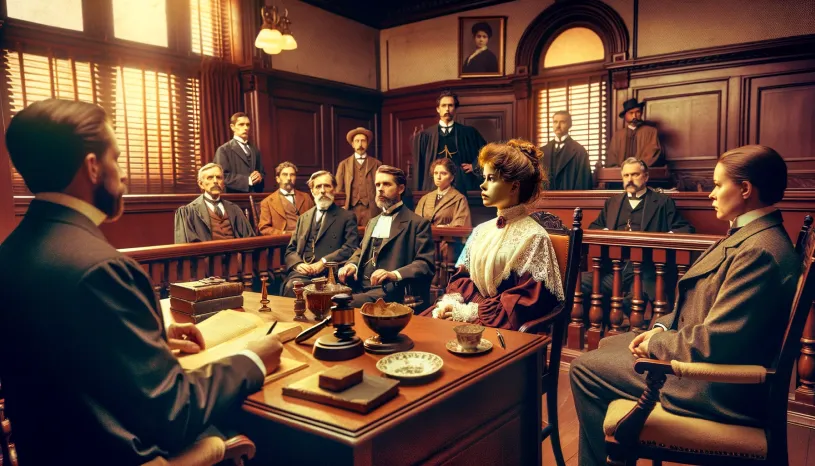Lizzie Borden, a seemingly respectable woman from a wealthy Massachusetts family, became a national sensation in 1892.
Accused of brutally murdering her father and stepmother with an axe, Lizzie Borden’s trial captivated the nation.
Despite public suspicion, she was acquitted, leaving behind a legacy of mystery and a case that continues to be debated to this day.
In this article:
Who Was Lizzie Borden?
Lizzie Andrew Borden (July 19, 1860 – June 1, 1927) was an American woman famously tried and acquitted for the axe murders of her father (Andrew Borden) and stepmother (Abby Borden) on August 4, 1892.
Yet—despite her acquittal—she remained a prime suspect in the murders and the subject of fascination and speculation due to the lack of tangible evidence incriminating her.
Born in Fall River’s High Society
Lizzie Borden was born in Fall River, Massachusetts. Her childhood was marked by early familial loss, traumas, and societal constraints that shaped her life.
Perhaps the most tragic loss was of her mother, Sarah Anthony Morse Borden, who died in 1863 when Lizzie was just a young child. This early loss profoundly impacted Lizzie and her older sister, Emma. The absence of their biological mother left a void in their lives, which was challenging to fill.
In 1865, Andrew Borden, Lizzie’s father, remarried Abby Durfee Gray. Lizzie and her sister Emma had a strained relationship with their stepmother.
They were not close to Abby and often referred to her as “Mrs. Borden” rather than as a mother figure.
On top of that, the two sisters also had to deal with their father, who was known to be a strict and frugal man.
Did you know?
Lizzie Borden was known for her love of animals, particularly dogs. She reportedly had several Boston Terriers and was involved in animal welfare activities. This softer aspect of her personality contrasts sharply with the brutal nature of the crime she was accused of.
Despite his wealth, he was very controlling over his daughters’ lives and finances. Lizzie and Emma had limited social opportunities and personal freedom. In short, Lizzie and Emma lived a life of material comfort but emotional sterility.
Finally, growing up in a conservative, patriarchal society, Lizzie faced societal constraints typical for women of her time. Her activities and roles were highly restricted, which further compounded her sense of frustration and confinement.
That’s probably why Lizzie and Emma (neither of whom married) were often labeled as spinsters—a term loaded with social prejudice and implications of failure to adhere to womanly duties.
The Infamous Axe Murders of 1892
On August 4, 1892, Fall River, Massachusetts, was rocked by a shocking crime.
Andrew and Abby Borden were found brutally murdered in their home, sparking widespread horror.
Both were killed with an axe-like weapon. Andrew in the sitting room. Abby upstairs. This suggests a personal motive.
Strangely enough, there was no evidence of forced entry at the Borden house. Investigations revealed that all the doors and windows were either locked or securely fastened, and nothing indicated that an intruder had broken into the house.
Lizzie and the maid, Bridget Sullivan, were the only other individuals known to be in the house at the time of the murders. But here’s where things get complicated.
From the outset, Lizzie Borden was the main suspect. Suspicion fell on her due to several factors, including her inconsistent and changing testimonies and suspicious behavior.
For example, she claimed she was in the barn loft looking for a piece of iron when her father was murdered (which investigators found unlikely, given the heat and dust conditions in the barn).

Lizzie Borden’s Trial
The trial of Lizzie Borden started on June 5, 1893. It was a short one, but it managed to capture the entire nation’s attention.
The case against Lizzie was built on circumstantial evidence and heavily reported by the media, blurring the lines between fact and sensationalism.
Key pieces of evidence (such as a burned dress and Lizzie’s inconsistent alibi) became central to the prosecution. That despite the absence of direct proof linking Lizzie to the murders.
In the end, the reliance solely on circumstantial evidence allowed the defense lawyers to challenge the prosecution’s claims.
Here is a more detailed explanation:
1) Mostly circumstantial evidence
The prosecution’s case against Lizzie Borden was primarily based on circumstantial evidence. There was no direct evidence linking her to the murders, such as eyewitness testimony or a murder weapon with definitive proof of her involvement.
2) The defense strategy
The defense, led by former Massachusetts Governor George D. Robinson, effectively challenged the prosecution’s case by emphasizing the lack of direct evidence.
They successfully argued that the circumstantial evidence presented was insufficient to prove Lizzie’s guilt beyond a reasonable doubt.
Key points challenged by the defense:
- Inconsistencies in Testimonies: The defense highlighted inconsistencies and contradictions in witness testimonies, including those of Bridget Sullivan, the family maid.
- Lack of Blood Evidence: Lizzie was found to have no bloodstains on her clothing immediately after the murders, which the defense argued would be improbable if she had committed the crimes.
- Motive: While the prosecution suggested possible motives related to family tensions and financial disputes, the defense argued that these were speculative and not concrete evidence of guilt.
The defense’s ability to cast doubt on the prosecution’s circumstantial evidence contributed significantly to Lizzie Borden’s acquittal.
On June 20, 1893, the jury found her not guilty, concluding that the evidence presented did not meet the burden of proof required for a conviction.
Did you know?
The phrase “getting away with murder” is often attributed to the outcome of Lizzie Borden’s trial.
Westfield State University offers one of the most in-depth analyses and timelines of the events before, during, and after the trial (Read the 36-page document).
Societal Context and Public Perception
The trial of Lizzie Borden for the axe murders of her father and stepmother in 1892 is not only a landmark case in American legal history but also a pivotal moment in the intersection of media, gender politics, and societal norms during the Gilded Age.
Media Influence and Sensationalized Journalism
The trial of Lizzie Borden became a spectacle largely due to the media influence and sensationalized journalism of the time.
A bunch of newspapers across the country (such as the Boston Herald, Fall River Daily Herald, New Bedford Evening Standard, New York Recorder, or Woonsocket Call) capitalized on the public’s voracious appetite for scandal.
Using lurid details and sensational headlines, these newspapers often painted Borden as a cold-blooded killer before the trial even began.
The extensive media coverage skewed public opinion. Many people formed a guilty verdict in their minds before the trial, driven more by the sensational reports than by factual evidence.
As an interesting fact about Lizzie Borden, the press’s portrayal contributed to a widespread belief in her guilt, regardless of the actual trial proceedings and evidence presented.
This case is an early example of how media sensationalism can influence public perception and potentially impact the fairness of judicial proceedings.

What Happened to Lizzie Borden After the Trial?
After Lizzie Borden was acquitted in 1893 for the infamous axe murders of her father and stepmother, her life unfolded under the heavy shadow of public scrutiny and lingering suspicion.
Despite the notoriety, Lizzie sought to reclaim some semblance of normality and respectability within the same community that had eagerly watched her trial.
So, Lizzie and her sister Emma moved to a new home in the affluent “Hill” district of Fall River, Massachusetts. They purchased a large Victorian mansion at 306 French Street (which they named “Maplecroft”).
At Maplecroft, the sisters lived relatively comfortably, supported by their inheritance and several servants. Both tried to integrate into the social fabric of their new neighborhood, but Lizzie’s infamy made this challenging.
Interesting fact:
After the trial, Lizzie Borden attempted to distance herself from her infamous past by changing her name to Lizbeth A. Borden. She used this name until her death.
The strain of their circumstances eventually led to a rift between Lizzie and Emma.
By 1905, their relationship had deteriorated, and Emma left Maplecroft, moving away from Lizzie and the controversies associated with her.
While the exact reasons for their split remain unclear, it marked a significant turning point in their lives.
Lizzie remained at Maplecroft after Emma’s departure. She pursued interests in the arts—particularly theatre—and hosted social gatherings in an effort to find acceptance and perhaps some measure of redemption.
She also traveled, taking advantage of her financial means to seek adventure and escape.
Lizzie Borden died of pneumonia on June 1, 1927, in Fall River, at the age of 66. In a bizarre coincidence, her sister Emma died just nine days later, on June 10, 1927, in Newmarket, New Hampshire.
Their deaths marked the end of a long and tumultuous chapter in American criminal history.
The Legacy of Lizzie Borden in Popular Culture
The legacy of Lizzie Borden in popular culture is as varied as it is enduring, spanning across movies, TV shows, documentaries, books, and more.
Cinema:
- The Legend of Lizzie Borden (1975): This television film starred Elizabeth Montgomery and provided a dramatized account of the Borden case, focusing on Lizzie’s psychological and societal pressures.
- Lizzie (2018): This film starred Chloë Sevigny as Lizzie Borden and Kristen Stewart as Bridget Sullivan. It explored the relationship between the two women and the events leading up to the murders. The film offers a speculative take on the case, blending historical facts with fictional elements.
Television:
- The Lizzie Borden Chronicles (2015): A Lifetime series that imagines a fictionalized version of Lizzie Borden’s life after her acquittal, portraying her as a cunning and possibly guilty individual. Christina Ricci played Lizzie Borden in this series.
- Documentaries and Crime Series: Various TV documentaries and crime series, such as episodes of “Mysteries at the Museum” and “Biography,” have revisited the Borden case, offering analyses of the evidence and expert opinions on her possible guilt or innocence.
Literature:
- Biographical Works: Numerous biographical Lizzie Borden books attempt to unravel the truth behind the murders. Some worth mentioning include “Lizzie Borden: The Legend, the Truth, the Final Chapter” by Arnold R. Brown and “The Borden Murders: Lizzie Borden and the Trial of the Century” by Sarah Miller.
- Novels: Authors like Angela Carter, in her short story “The Fall River Axe Murders,” and Sarah Schmidt, in her novel “See What I Have Done,” have used the Borden case to explore deeper themes of human nature, freedom, and oppression.
American folklore and cultural memory:
- Children’s rhyme: The infamous “Lizzie Borden took an axe” rhyme has become a part of American folklore.
- References and parodies: The Borden case has inspired numerous references and parodies in popular culture, including in music, theatre, and even cartoons.
The Famous Rhyme
The famous rhyme associated with Lizzie Borden began circulating shortly after her trial, immortalizing the case in American folklore with its simple, yet macabre skipping-rope rhyme:
Lizzie Borden took an axe
She gave her mother forty whacks.
When she saw what she had done
She gave her father forty-one.
Lizzie Borden got away
For her crime, she did not pay.
Despite its factual inaccuracies—Abby Borden was her stepmother, and the actual number of blows dealt to each victim was far less—the rhyme encapsulated the public’s fascination with the case.
Its origins are murky—likely a product of the sensational journalism of the time, which played a significant role in shaping the narrative around the Borden murders. Nevertheless, the rhyme’s catchy rhythm and stark imagery made it memorable.
The impact of this simple verse on the public’s perception cannot be overstated.
It contributed significantly to the mythologizing of Lizzie Borden, transforming her from a figure of a murder trial into a character of legend.
The rhyme distilled complex societal issues—such as the tensions around gender norms, family dynamics, and class distinctions—into a straightforward and compelling story that was easy to remember and retell.
This transformation of a legal case into folklore through the rhyme played a crucial role in sustaining public interest in the Borden case well into the present day.
Frequently Asked Questions
Who were the victims of the Lizzie Borden murders?
The victims of the Lizzie Borden murders were her father, Andrew Borden, and her stepmother, Abby Borden.
Why was Lizzie Borden acquitted?
Lizzie Borden was acquitted after a fifteen-day trial that ended on June 20, 1893. The jury found her not guilty because most of the prosecution’s case was based on circumstantial evidence. Despite suspicions and accusations, the lack of concrete evidence led to her acquittal.
Did Lizzie Borden inherit a lot of money?
After the murders of her father and stepmother, Lizzie Borden inherited a substantial estate valued at around $300,000 (about $10,500,000 today).
What was Lizzie Borden’s relationship like with her father and stepmother?
Lizzie Borden’s relationship with her father, Andrew Borden, and stepmother, Abby Borden, was strained. There were conflicts within the family, disagreements over property division, and allegations of abuse (however, the existing sources seem to instead indicate that the specific allegations of abuse are not definitively supported by historical records). Lizzie and her sister Emma had disputes with their father over various issues, including his decisions regarding property division and the alleged killing of Lizzie’s pigeons.
Was Lizzie Borden ever married?
Lizzie Borden never married. She lived with her sister Emma in Fall River after the murders until they eventually grew apart and went their separate ways. Lizzie spent the rest of her days in Fall River until she died in 1927.
How did the media portray Lizzie Borden?
The media coverage surrounding Lizzie Borden was extensive and varied. While some sources promoted rumors about her family pooling money to ensure her acquittal, others defended her innocence. The media highlighted inconsistencies in Lizzie’s testimony during the trial but also portrayed support for her from women’s groups like the Women’s Christian Temperance Union and suffragists.







